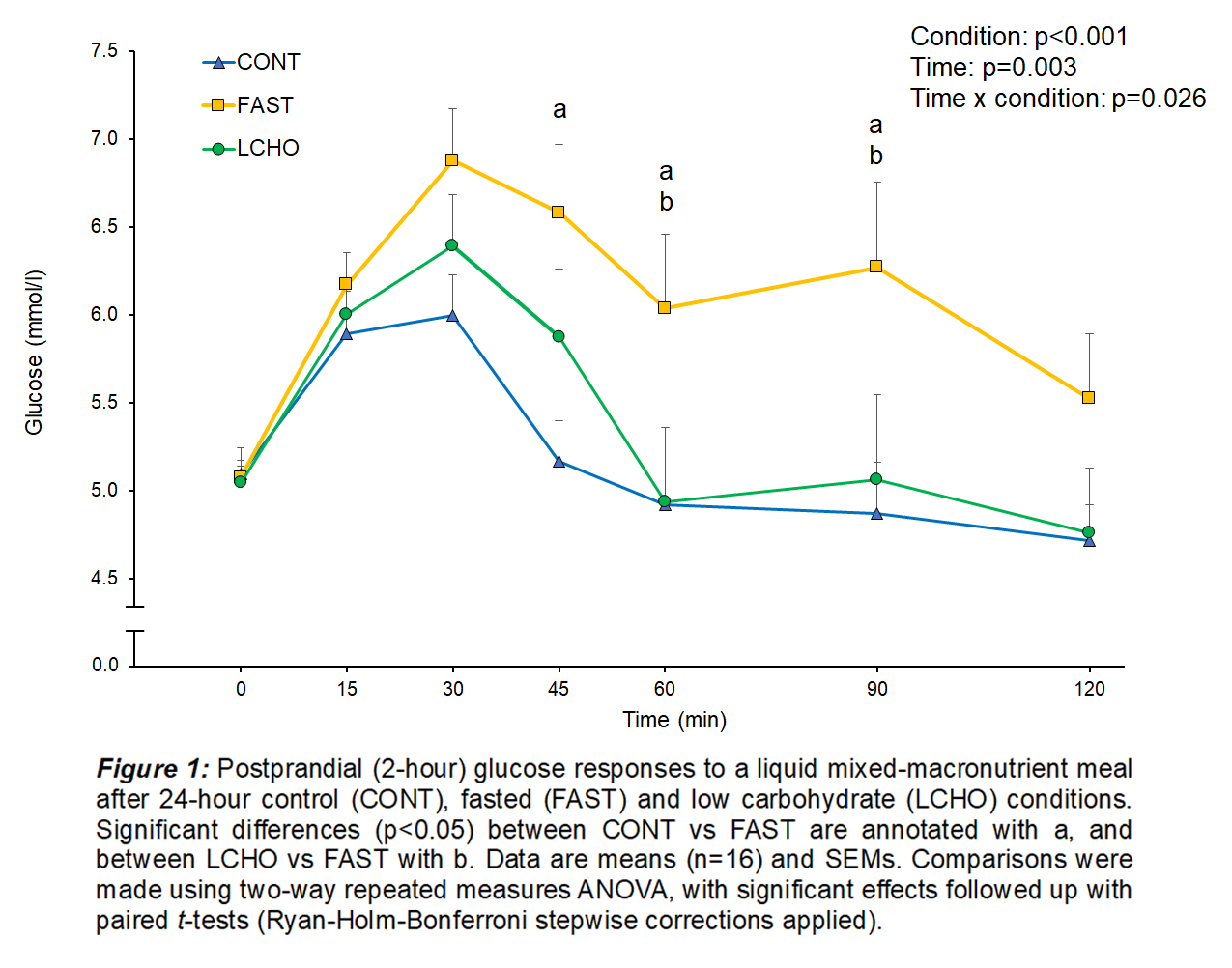Intermittent fasting is a popular dietary strategy involving repeated bouts of substantial energy restriction (ER). Over ~24 hours, fasting induces marked alterations in metabolic substrate utilisation that are partially a consequence of low carbohydrate (CHO) availability. Few studies have explored the effects of acute fasts on postprandial glucose and triglyceride (TAG) responses (Antoni et al., 2016; Clayton et al., 2018), which are independent predictors of cardiometabolic risk. This study investigated the effects of a 24-hour fast and a time-matched period of low CHO intake without ER on postprandial glucose and TAG concentrations in healthy volunteers.
In a randomised crossover design, 16 healthy adults (13 males, body mass index 24.8±3.3 kg/m2, mean±SD) completed three 24-hour dietary conditions in counterbalanced order: i) fasting (FAST; 0 kcal); ii) CHO restriction without ER (LCHO, ≤20g CHO; 1923±339 kcal); iii) control diet without ER (CONT, >150g CHO; 2004±360 kcal). Participants consumed a mixed-macronutrient liquid meal standardised to 1/3 of their resting metabolic requirements immediately after each condition. Fasting capillary beta-hydroxybutyrate (BHB) concentrations were measured, and blood samples were collected at baseline and regular postprandial intervals for 120min to quantify plasma glucose and TAG concentrations. Time-course data were analysed using two-way repeated measures ANOVA. Area under the curve (AUC) and BHB data were analysed using one-way repeated measures ANOVA. Significant effects were followed up with paired t-tests and application of Ryan-Holm-Bonferroni stepwise corrections.
Plasma glucose concentrations displayed a significant time x condition interaction effect (p=0.026). Glucose incremental AUC (iAUC) increased after FAST (148.7±146.0 mmol/L*120min) compared to LCHO (81.4±81.5 mmol/L*120min, p=0.029) and CONT (55.8±46.3 mmol/L*120min, p=0.027). Plasma TAG responses diverged between conditions (time x condition, p=0.012) and were highest after CONT and lowest after FAST. Decreases in TAG concentrations were observed at 60min (0.691±0.229 mmol/L, p=0.028) and 120min after (0.856±0.320mmol/L, p=0.023) FAST, and at 120min after LCHO (0.950±0.525 mmol/L, p=0.021) relative to CONT (60min 0.975±0.472 mmol/L; 120min 1.195±0.519 mmol/L). TAG total AUC was lower after FAST (88.1±27.9mmol/L*120min, p=0.018) and LCHO (99.6±12.1mmol/L*120min, p=0.017) compared to CONT (115.1±49.2 mmol/L*120min), while TAG iAUC decreased after FAST (5.5±9.0 mmol/L*120min, p=0.028) relative to CONT (20.5±19.1 mmol/L*120min, p=0.028) and LCHO (16.5±15.0 mmol/L*120min, p=0.036). Fasting BHB increased after FAST (0.4±0.2 mmol/l, p=0.002) and LCHO (0.2±0.2 mmol/l, p=0.006) compared to CONT (0.1±0.1 mmol/l).
These findings demonstrate that a 24-hour period of low CHO intake, with or without ER, reduces postprandial TAG concentrations in healthy adults, an effect previously observed after 36-hour complete or partial ER in participants with overweight and obesity (Antoni et al., 2016). Low CHO availability alters hepatic fatty acid partitioning towards increased β-oxidation and ketogenesis, thus away from TAG export into the circulation within very low-density lipoproteins, providing an explanation for the reduction in postprandial TAG concentrations. Repeated periods of fasting and CHO restriction may be clinically relevant in postprandial lipid management independently from weight loss, with longer-term studies needed to explore their application in populations at increased cardiometabolic risk. Whether regular fasting negatively impacts glycaemic control also warrants further investigation, particularly in populations with existing impairments in glucose tolerance.


